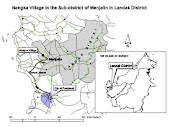 Location
LocationKampung (a unit of self-governance community) Nangka is located in the Sub-district of Menjalin, in Landak District. It is about 120 kilometers Northeast of Pontianak. It takes 2 to 3 hours of drive to take to this kampung.The Sub-district of Menjalin is on the road network that connects Anjungan – Darit – Bengkayang. This road network is not as busy as the one that connects Pontianak – Sanggau – Kuching (Sarawak, Malaysia).
Demography, Etnology
Based on 2010 data, Kampung Nangka is populated by 441 people or 57 families. As other indigenous self-governance community units in the province, Kampung Nangka is on the dualism of governance. In 1980s the provincial government, in compliance to the law of village administration of the time, grouped clusters of kampungs to form a new unit of administration called desa. A new administrative structure was created to replace the self-governance community unit.
The indigenous communities living in most part of Landak District and a part of Pontianak District belong to a large linguistic group commonly called ”Orang Ba’ahe” (people who often utter the word ahe when speaking their language) or ”Orang Banana’” (people who often utter the word nana’ when speaking their language). In 1980s, however, some people re-discovered the term ’kanayatn’ (with variants: Kandayan or Kendayan) to name this group. As this people also belong to the generic group of Dayaks, people often refer them as ”Ba’ahe Dayak”, ”Banana’ Dayak” or ”Kanayatn Dayak.” The poeple of Kampung Nangka belong to this group. However at the kampung level or at the binua (a binua is a federalistic unit consisting of several kampungs belonging to the same genealogic tree) level, people name themself after their binua name. The people of Nangka claim that they are ”Orang Kaca’” since their kampung belongs to a binua called ”Binua Kaca’ Ilir”.
Economy
Most of Nangka people subsist on their dry-land cultivation and agroforestry management. The agroforest that contribute significantly to their economy is the rubber gardens. Agroforest containing fruit trees, especially durian trees (such as kompokng and timawakng) gives good income, too. But of course fruits cannot be picked everyday as rubber can be tapped.
Some of Nangka people have, of course, other professions like teaching (at the elementary schools and junior high scool in the kampung) and managing small shops, but they also do basic activities of dry-land cultivation and managing their rubber gardens.
Some people develop wet-land cultivation and most of the wet-rice fields produce good yield. But wet-land cultivation can only be done whereever water supply is available. So, this economic activity is limited, due to the absence of water irrigation.
It is hard to portray the extent of welfare of Nangka community. There are various variables to take into account. So, in this field trip it will be good for the participants to collect information during the discussions with the community members to get picture of the community well being.
Ancestral Origin
The history of the community can be traced through the oral history of their agroforests. It is estimated that the durian kompokng in the Village of Nangka dates back to 300 years ago. The agroforest largest in area on Sapatutn hill was formerly the settlement of the Nangka ancestors. They came from Babah Are’. Some 15 family stayed on Babah Are; height in avoidance of the attack made by the people from Banyuke during the head-hunting time. As the head-hunting period ended, the gradually went downhill to settle in a new place calle Tumiang. In Tumiang there were already another 8 families led by Nek Danggol. We can trace this through the fact that now the durian trees in Tumiang are managed by the descendants of the 8 families. From Tumiang they migrated to new forested-land area where they found a lot of nangka or cempedak (a kind of jackfruit) trees.
In this village there are also 5 sacred places believed to protect the whol village. Three out of the 5 sacred places are in within durian gardens. At this sacred places, the community members make rituals to pray for good yield. The sacred places are called Pantulak Nek Donggol, Batu Diri Nek Siru, Bukit Kanyet and Paburungan.
Self-Governance
It is said previously that as other indigenous self-governance community units in the province, Kampung Nangka is on the dualism of governance. Nangka has its own indigenous community governance. At the kampung level, Nangka has a leader who coordinates socio-political activities. Among the motivators are the ones called locally ’tuha ale’atn. ’Ale’atn is a collective labor management of dry-field cultivation. One ale’atn group consists of 10 to 40 cultivators.
Nangka and other kampungs that belong to the same genealogical tree are united in a federalistic unit called binua. Binua leadership functions more as an appeal of cases that cannot be solved at kampung level.
As Dayak communities in other places, Nangka communitiy always start their activity with a prayer called nyangahatn. Nyangahatn is an epitome of philosophy and ethics of Dayak communities. In a nyangahatn all stakeholders are greeted and be informed the purposes of activity to be conducted. The priest expresses expectation that all stakeholders can co-exist and cooperate, and for this one of the stakeholder, human being, make offerings to other beings. This is the economy-politics of the indigenous community. (Source: Y. Yadi, Krist. Editing & map: Petrus BS)
Read More....
 Gerakan Bala Saribu adalah aksi partisipatif untuk pembangunan gerja Katolik SANTO THOMAS AQUINAS di Desa Nangka, Kabupaten Landak. Sejarah gereja Katolik di Kalbar tak lepas dari kampung ini, karena sebelum pusat Paroki Menjalin Kabupaten Landak berdiri 1935, justru warga DesaNangka lah pertama kali dibaptis menjadi Katolik tahun 1932 silam.
Gerakan Bala Saribu adalah aksi partisipatif untuk pembangunan gerja Katolik SANTO THOMAS AQUINAS di Desa Nangka, Kabupaten Landak. Sejarah gereja Katolik di Kalbar tak lepas dari kampung ini, karena sebelum pusat Paroki Menjalin Kabupaten Landak berdiri 1935, justru warga DesaNangka lah pertama kali dibaptis menjadi Katolik tahun 1932 silam.










